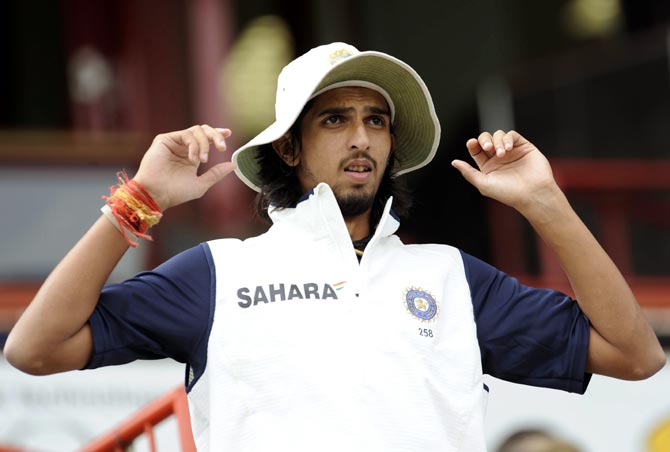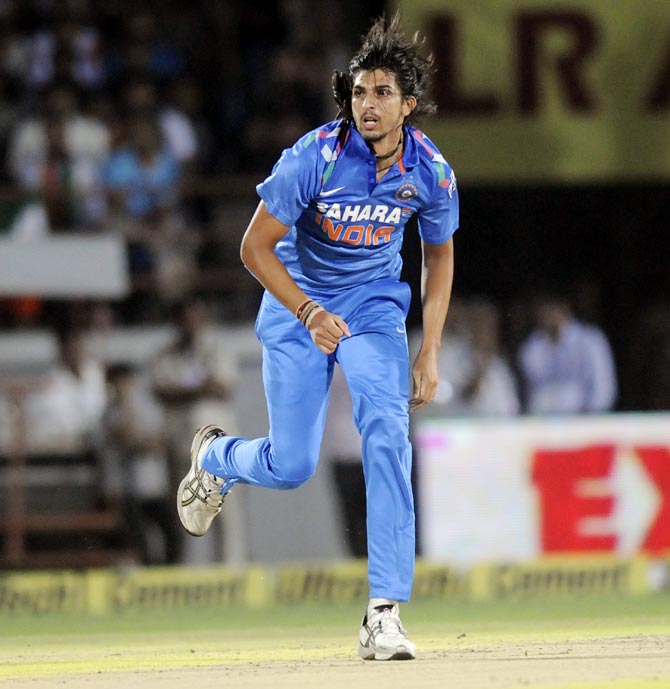
Statistician Rajneesh Gupta explains why Ishant Sharma should not have been retained in the squad for the ongoing ODIs against Australia.
A lot has been said about Ishant Sharma in the last couple of days after his horrendous performance in the third One-Day International against Australia, at Mohali, on Saturday.
While most cricket-lovers wanted the pacer dropped from the squad immediately, his team-mates, particularly skipper Mahendra Singh Dhoni, felt he needed to be given more chances.
Their argument: how can someone be dropped on the basis of just one bad performance?
- Should Ishant Sharma have been dropped?
While this can't be rejected straightaway, one has to take into consideration whether a bowler like Ishant has evolved since making his debut in 2007, or his performances have gone gone downhill with every match.
Thus, we have delved into the figures of current Indian bowlers to gauge how they performed in ODIs. The bowlers' performance has been taken into consideration, their figures sorted on economy-rate (runs conceded per over) and then clubbed in to four categories -- economy less than four runs per over, between four and five, between five and six; and above six. Thereafter, we calculated percentage for each category. The study should give us a fairly good idea about a bowler's calibre.
First, a disclaimer. Jaydev Unadkat and Shami Ahmed are the new faces in the squad and haven’t yet played enough matches to make a definite opinion about them.

Table A gives details for regular bowlers, while table B gives details of part-timers:
Table A: Break-up of economy of India's regular bowlers:
| Runs per over | |||
| Less than 4 | Between 4 & 5 | Between 5 & 6 | More than 6 |
Bhuvneshwar Kumar | 45 | 20 | 10 | 25 |
Ishant Sharma | 13 | 27 | 19 | 40 |
R Vinay Kumar | 10 | 24 | 28 | 38 |
Jaydev Unadkat | 100 | 0 | 0 | 0 |
Shami Ahmed | 36 | 18 | 27 | 18 |
Ravinder Jadeja | 35 | 31 | 16 | 18 |
Amit Mishra | 22 | 56 | 22 | 0 |
R Ashwin | 22 | 42 | 18 | 18 |
Yuvraj Singh | 16 | 32 | 23 | 29 |
Table B: Break-up of economy of India's part-time bowlers:
| Runs per over | |||
| Less than 4 | Between 4 & 5 | Between 5 & 6 | More than 6 |
Suresh Raina | 21 | 32 | 17 | 30 |
Rohit Sharma | 26 | 32 | 9 | 32 |
Virat Kohli | 17 | 10 | 24 | 48 |

If you check the figures in the two tables, they are rather mind-boggling!
For example, Bhuvneshwar has conceded less than four runs per over in 45 percent of the ODIs he played. On 20 percent occasions, he conceded between four and five runs per over. This means 65 percent times Bhuvneshwar has gone for five runs or less in an ODI, which is a fairly good performance.
- Should Ishant Sharma have been dropped?
Similarly, Ravindra Jadeja concedes five runs or less in 66 percent of his matches. This coupled with his ability to take crucial wickets makes Jadeja one of India's most reliable bowlers.
A detailed look at Ishant’s figures reveal the whole story. He has conceded less than four runs only in 13 percent of the games in ODIs (which is once in more than seven games). He has gone on to concede more than six runs per over a mind-boggling 40% times!
And this 40% forms the biggest block for Ishant across different categories, which means he is more likely to feature in this category (conceding six runs or more) than any other category.
R Vinay Kumar is even worse, conceding five runs or more, a whopping 66% times. Even though he is a thinking bowler, the lack of pace in his bowling and trying too many variations is his undoing.
If a newcomer like Bhuvneshwar can perform exceptionally well despite his limitations, a seasoned bowler like Ishant is definitely supposed to perform even better.
But, as we can see, Ishant does not really deserve the faith his captain and other team-mates have reposed in his capabilities. Mind you, we have taken the full career into consideration and not just a few games.
Clearly, Ishant needs to sit at the drawing board and sort out the flaws in his bowling first. Otherwise, he will keep on getting hit, like at Mohali, giving matches to the opposition on a platter quite regularly.